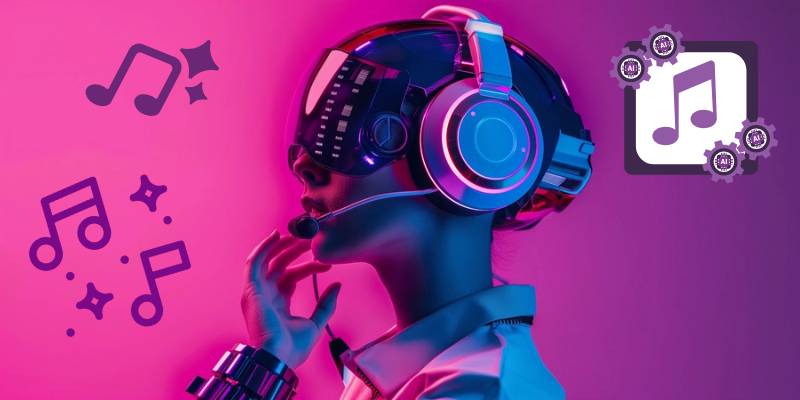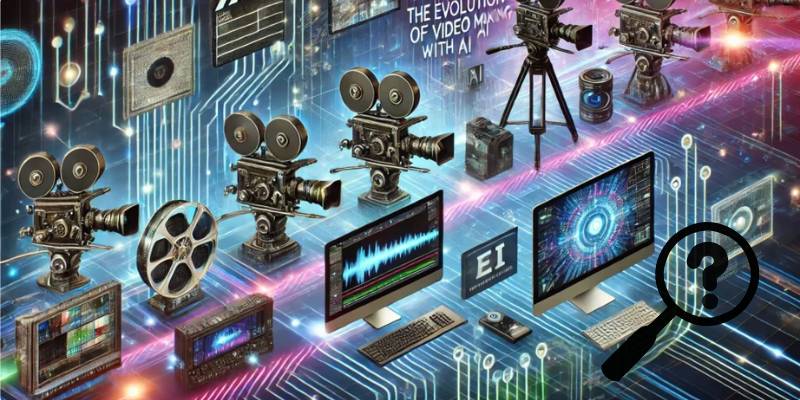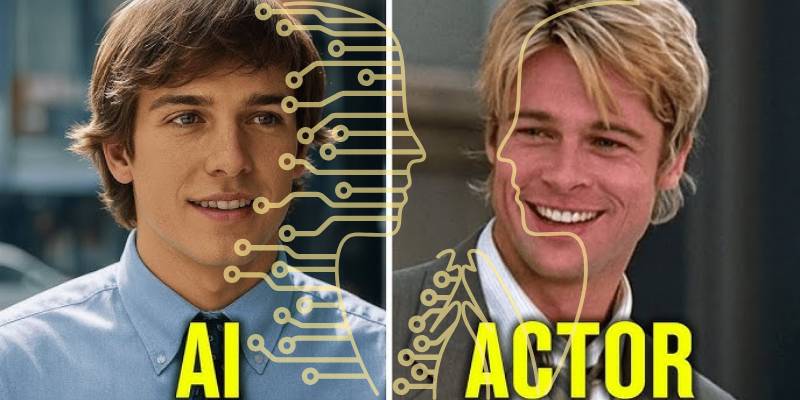There’s something magical about music videos. They’ve always been more than just visual add-ons to a song—they’re cultural artifacts, emotional triggers, sometimes even artistic revolutions.
From the glossy MTV era of the 1980s to the stripped-down intimacy of YouTube performances, videos have shaped the way we hear and feel music.
Now, we’re entering a new phase: AI-generated music videos. A few years ago, the idea of typing a song lyric into a computer and watching it turn into a full video would have sounded like science fiction. Today, it’s becoming reality.
But here’s where it gets complicated. Is this the dawn of limitless creative freedom, or the start of a slow erosion of authenticity in music culture?
Will AI be a collaborator for artists or a competitor? And more personally—can something made by code ever give us the goosebumps that a raw, human-made piece of art does?
I want to explore all sides of this, from the thrill of creative experiments to the risks of over-automation, from the excitement of AI for musicians and animators to the thorny issues of ownership and originality.
Chapter 1: The Rise of AI in Visual Storytelling
First, let’s set the scene.
AI is no longer just a backend tool. It’s front and center in creative industries. Generative models like Stable Diffusion, MidJourney, and Runway have exploded, letting anyone create compelling visuals from text prompts.
In video, tools like Runway Gen-2, Pika Labs, and Kaiber specialize in turning text, images, or even audio tracks into short animated clips.
For music, this means videos can be generated on the fly. A musician can upload a track, type a few prompts describing the mood (“dreamy forest with neon rivers”), and boom—a video syncs to the beat.
According to MarketsandMarkets, the AI in media and entertainment market is projected to grow from $14.7 billion in 2022 to $99.48 billion by 2030. Music videos are just one piece of that puzzle, but they represent one of the most culturally impactful applications.
Chapter 2: Creative Experiments
This is where things get exciting.
Musicians have always experimented with visuals. Think of Björk’s surreal videos, or OK Go’s elaborate one-take productions. But these were expensive, logistically intense projects. Now, with AI, creative experiments can happen at a fraction of the cost and time.
Imagine an indie artist who doesn’t have the budget for a director or set design. AI tools can generate cinematic visuals that amplify their song without bankrupting them.
We’re seeing a democratization of visual music storytelling—where small creators can punch way above their weight.
That doesn’t mean it’s easy. You still need vision, taste, and curation. AI doesn’t magically spit out brilliance; it spits out raw material. But for those willing to tinker, it opens doors that were previously shut.
Chapter 3: Best Generators for Music
Let’s get practical. What are the best generators for music videos right now?
- Kaiber: Known for its ability to animate images and create videos that move with the beat of a track. Great for abstract, surreal visuals.
- Runway Gen-2: More cinematic, offering short video clips generated from text or images. It’s quickly becoming a favorite among experimental artists.
- Pika Labs: Strong in creating animated shorts from prompts, though it’s still evolving.
- Stable Diffusion with Deforum: For those who like customization, Deforum lets you generate long, evolving AI animations synced to audio.
- Synthesia: More polished, often used for corporate or straightforward lyric-style videos, but it’s creeping into music territory too.
Each has strengths and weaknesses. Some excel at abstract “vibe videos,” others are better at producing more coherent narratives. None are perfect yet, but the progress has been staggering.
Chapter 4: Automated Storytelling in Music
Here’s where AI really flexes: automated storytelling in music.
Traditionally, a music video involves brainstorming, storyboarding, shooting, editing—all labor-intensive processes. AI tools collapse that pipeline. They can analyze a song’s rhythm and mood, then generate visuals that align with it.
Some systems even sync visual transitions to the beat automatically. That means you don’t have to cut footage manually—it happens in real time.
The question is, does automation kill creativity, or does it amplify it? Personally, I think it depends on how it’s used. If musicians rely on AI as a crutch, videos might feel generic. But if they use it as a collaborator, it could spark new visual languages we haven’t seen before.
Chapter 5: AI for Musicians and Animators
This is a huge one: how does AI impact careers?
For musicians, AI lowers barriers. A solo artist can now produce a video that rivals major-label productions. For animators, though, the situation is more nuanced. AI can replace some labor, but it can also act as a tool to accelerate workflows.
The phrase AI for musicians and animators doesn’t have to mean competition. It can mean collaboration.
Animators can use AI for rough drafts, idea generation, or rotoscoping, then refine the output with their human skill. Musicians can use it to test different vibes before committing to a direction.
But I empathize with the anxiety too. If labels start cutting budgets by leaning on AI instead of hiring human teams, it could squeeze out creative professionals. This isn’t theoretical—it’s already happening in adjacent fields like stock photography.
Chapter 6: Ownership and Copyright
One of the biggest ethical and legal dilemmas around AI videos is ownership.
- Who owns an AI-generated video? The person who prompted it? The AI company?
- What if the AI tool was trained on copyrighted material? Are those artists being exploited?
- If an AI-generated video goes viral, who profits?
Right now, laws are murky. In the U.S., the Copyright Office has ruled that fully AI-generated works aren’t eligible for copyright. That creates a legal limbo where musicians can’t fully protect their AI-created videos.
This uncertainty could become a barrier for adoption, especially for professionals who rely on intellectual property protections.
Chapter 7: The Missing Human Touch
As dazzling as AI visuals can be, there’s something missing sometimes.
Call it warmth, call it imperfection, call it soul. Whatever it is, it’s the missing human touch. Human-directed videos often carry subtle cues—body language, atmosphere, accidents on set—that AI just can’t replicate.
When I watch an AI-generated video, I often marvel at the technical skill but feel emotionally detached. It’s like eating a perfectly engineered meal that tastes… fine, but doesn’t comfort you the way your grandmother’s cooking does.
That doesn’t mean AI videos are doomed to be soulless. It just means musicians and creators will need to figure out how to inject humanity into the process—whether through hybrid workflows, narrative depth, or raw performance clips woven into AI visuals.
Chapter 8: Risks and Concerns
Beyond artistry, there are real concerns:
- Misinformation: Music videos could be weaponized to spread political or cultural propaganda disguised as art.
- Exploitation: Unscrupulous companies might use AI to create videos using the likeness of real people without consent.
- Job loss: Production crews, editors, animators—all could be sidelined if AI dominates.
- Homogenization: AI tends to remix existing styles, which could lead to a flood of lookalike videos.
These risks shouldn’t be dismissed. They need to be addressed proactively, through policy, industry standards, and consumer awareness.
Chapter 9: Case Studies
- Grimes x Kaiber: The musician Grimes has been vocal about embracing AI, even open-sourcing her voice for AI projects. She’s used AI tools like Kaiber to create visuals for her experimental tracks.
- IDLES AI Video: The punk band IDLES leaned into AI visuals for one of their singles, creating a glitchy, surreal video that matched their chaotic sound.
- Independent artists on TikTok: Countless indie musicians are experimenting with AI visuals to gain traction on TikTok, where attention spans are short but visuals are everything.
These examples show that AI videos aren’t just theoretical—they’re shaping music culture right now.
Chapter 10: Audience Perception
The million-dollar question: do audiences care?
Surveys suggest yes and no. A 2023 Ipsos report found that 62% of people distrust AI-generated content if it’s not labeled, but younger audiences are more open, especially if the video feels authentic.
Ultimately, I think audiences value honesty. If a musician says, “I made this wild video with AI, isn’t it cool?” fans are likely to appreciate the transparency. But if AI is used to deceive, backlash will follow.
Chapter 11: Future Predictions
Where does this go next? Here are some future predictions:
- Mainstream adoption: By 2030, most music videos will likely incorporate AI in some form, whether for visuals, editing, or effects.
- Hybrid workflows: The most successful videos will combine AI generation with human direction, striking a balance between efficiency and authenticity.
- Regulation: Expect clearer copyright laws around AI-generated works, possibly requiring disclosure labels.
- Cultural shifts: Just as music itself has evolved with technology (vinyl to streaming), music videos will evolve into new forms we can’t fully predict yet.
Chapter 12: My Personal Take
I’ll be candid: I’m torn.
On one hand, I’m thrilled by the possibilities. The idea that a broke 18-year-old with a laptop can create a mind-bending video for their first single? That’s inspiring. On the other, I mourn the potential loss of human artistry in the process.
For me, the sweet spot is collaboration. AI shouldn’t replace directors, animators, or musicians—it should sit beside them, offering new tools for expression.
The magic of music videos has always been the fusion of sound and vision. With AI, that fusion can take new, unimaginable forms. But only if we guard against losing the messy, imperfect, deeply human spark that makes art matter in the first place.
Conclusion
AI-generated music videos are not just a passing trend. They’re part of a larger shift in how we create, share, and experience art.
They embody thrilling creative experiments, new opportunities through the best generators for music, fresh workflows in AI for musicians and animators, and the promise of automated storytelling in music.
But they also carry risks—ethical, legal, cultural—that we can’t ignore. The challenge now is to embrace the innovation while protecting the humanity that makes music videos more than just moving pictures.
Because at the end of the day, a music video isn’t just about visuals. It’s about making us feel. And whether that comes from a camera or a codebase, that feeling will always be the measure of success.


